Furniture Blog
Custom Furniture Gallery
Making Wood from Weeds
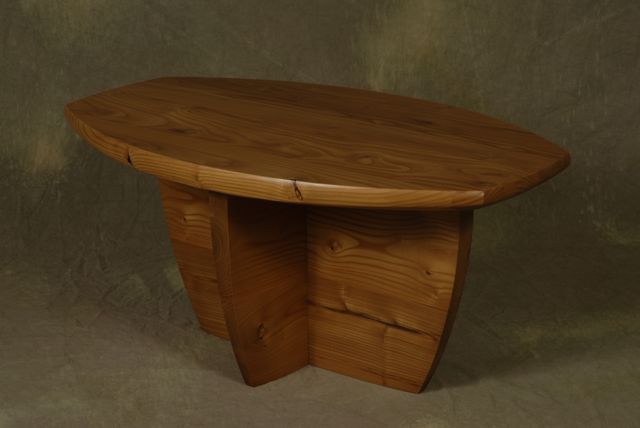
We don't think about the biggest ecological disaster in US history very much these days. When we think of the Dustbowl at all we think Grapes of Wrath and displaced people searching for a place to go where it rained and food grew. We don't think about the huge, almost daily, sky blotting "dusters" that buried houses, fences and livestock in drifting dunes, filled peoples lungs with dirt and dropped tons of dust in far away places like Chicago and Washington D.C. The price of wheat was high in the early 1900's and the US government was still giving away land for homesteading. People were moving out west, plowing the short grass prairies under, growing record wheat crops and making a lot of money. What they didn't realize was that they were living in an historically wet period. When the precipitation returned to 'normal' the amazing topsoil, that had built up over thousands of years, quickly began to blow away.
With the dusters blowing up and dunes covering large parts of Colorado, New Mexico, Oklahoma, Kansas and Texas, the newly formed Soil Conservation Service was desperate to find plants that would grow in these new conditions and hold down the soil that remained. They found some. It pretty much worked.
As a Landscape Architecture student in college I took semesters of classes on landscape plants. Occasionally we would learn about a plant that was originally brought to the country for 'soil stabilization'. I thought they were talking about highway embankments! I didn't realize that someone imported them to try to hold down the middle of the continent. The legacy of the dustbowl continues 80 years later with these invasive species.
 You might be familiar with the Russian Olive (Elaeagnus angustifolia); that hardy little tree with the pretty blue/green leaves and the fragrant yellow flowers that pop out in early June. As a landscape ornamental it has a lot to offer. As a member of the ecosystem, however, there are a few strikes against it. Introduced in the early 1800's for windbreaks, stabilization, and reclamation it has since spread aggressively throughout the country crowding out native species along the way. It is a particular problem here in the west where the Olive, along with Salt Cedar, tamarisk and Chinese Elm is taking over many of our riparian areas. Not only can it eventually create a monoculture, but it is also a thirsty little character that can suck drainages dry, contributing to the difficulties of the native species.
You might be familiar with the Russian Olive (Elaeagnus angustifolia); that hardy little tree with the pretty blue/green leaves and the fragrant yellow flowers that pop out in early June. As a landscape ornamental it has a lot to offer. As a member of the ecosystem, however, there are a few strikes against it. Introduced in the early 1800's for windbreaks, stabilization, and reclamation it has since spread aggressively throughout the country crowding out native species along the way. It is a particular problem here in the west where the Olive, along with Salt Cedar, tamarisk and Chinese Elm is taking over many of our riparian areas. Not only can it eventually create a monoculture, but it is also a thirsty little character that can suck drainages dry, contributing to the difficulties of the native species.
Enter This email address is being protected from spambots. You need JavaScript enabled to view it. . Steve does riparian restoration projects that involve, among other things, pulling out invasive species and re-establishing native plant communities. After cutting out Russian Olive thickets and pulling the stumps he has seen the stump holes fill with water, and springs that hadn't run in years start to flow again once the Olives were no longer sucking the aquifer down. Wanting to take his projects full circle, Steve started wondering if there wasn't a way to make use of the material that he was taking out on his projects. With this in mind he called me.
As a builder of custom wood furniture one of my few laments living here in NM is that there really aren't local hardwoods available for my work. (although I did get my hands on some beautiful drought killed Walnut trees in Espanola a few years back) Everything has to be shipped in from elsewhere. Steve was familiar with my love of interesting wood and wondered what I knew about the working qualities of Russian Olive. As it turned out I didn't know anything. Nor did anyone else. It usually doesn't get big enough to be timber quality and isn't ever sawn into lumber. Being the curious type, and since Steve had some particularly large Olives to take down, I decided to experiment a little and have a trailer load of logs sawn up. When I went to pick up my load from the sawyer I was stunned. The wood was beautiful; kind of a coffee and cream with a hint of cinnamon. It has a certain depth and sparkle that you only see in some of our domestic hardwoods. And it is as "Green" as it gets.
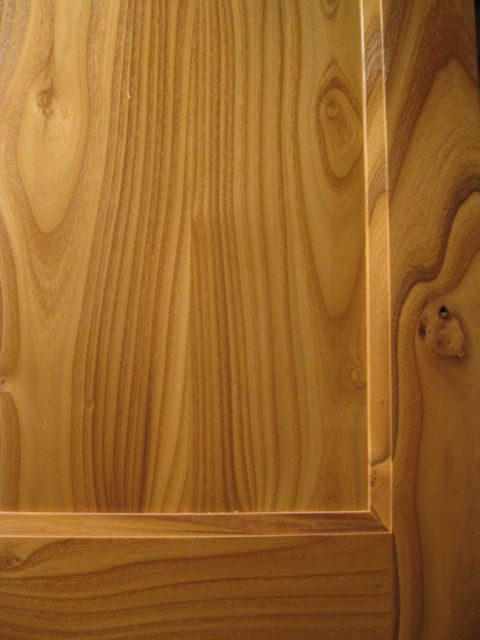 When I remodeled my kitchen I decided to use that olive wood for the doors and drawer faces and it is really beautiful. One of the things that makes my work look like my work is that, for the most part I don't stain anything. I prefer to find lumber that is the color the client is looking for; I believe the wood is far more beautiful than any stain. Lots of my clients want their furniture to be a medium brown color. Unfortunately, there aren't many commercially available species that are in that color range. Walnut is darker, cherry is in the orangey brown range, butternut is too soft and not very available. But Russian Olive is already a medium brown color and it has lots of "life" in its subtle color variations and patterns. It would be great to have a supply of this weed to offer to my clients.
When I remodeled my kitchen I decided to use that olive wood for the doors and drawer faces and it is really beautiful. One of the things that makes my work look like my work is that, for the most part I don't stain anything. I prefer to find lumber that is the color the client is looking for; I believe the wood is far more beautiful than any stain. Lots of my clients want their furniture to be a medium brown color. Unfortunately, there aren't many commercially available species that are in that color range. Walnut is darker, cherry is in the orangey brown range, butternut is too soft and not very available. But Russian Olive is already a medium brown color and it has lots of "life" in its subtle color variations and patterns. It would be great to have a supply of this weed to offer to my clients.
Steve recently called me again about a big restoration project that was happening in Diablo Canyon on the Rio Grande west of Santa Fe. They were taking out acres of invasive trees with the idea of giving the cottonwoods a chance to get re-established. We took a ride out there and the contractor was nice enough to load some of those trees onto my trailer.
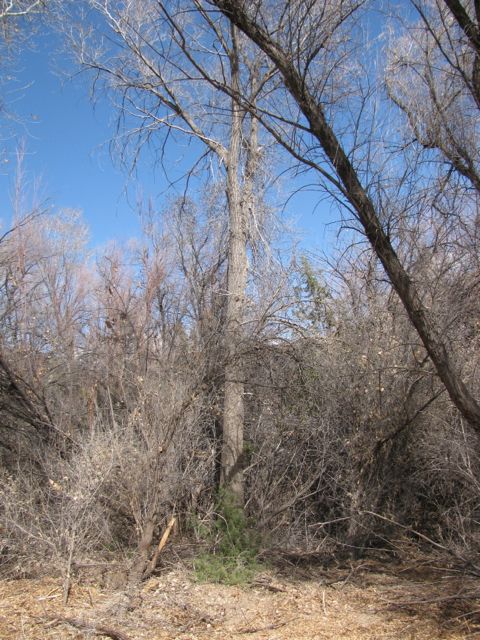 The bosque in that area was completely choked with invasive species like this large Chinese Elm and the tamarisk below it. This tree was 22" in diameter and 20' to the first large branch. A perfect timber tree. The wood of the Chinese Elm is a really nice mocha color with a light sap wood and has open grain like oak.
The bosque in that area was completely choked with invasive species like this large Chinese Elm and the tamarisk below it. This tree was 22" in diameter and 20' to the first large branch. A perfect timber tree. The wood of the Chinese Elm is a really nice mocha color with a light sap wood and has open grain like oak.
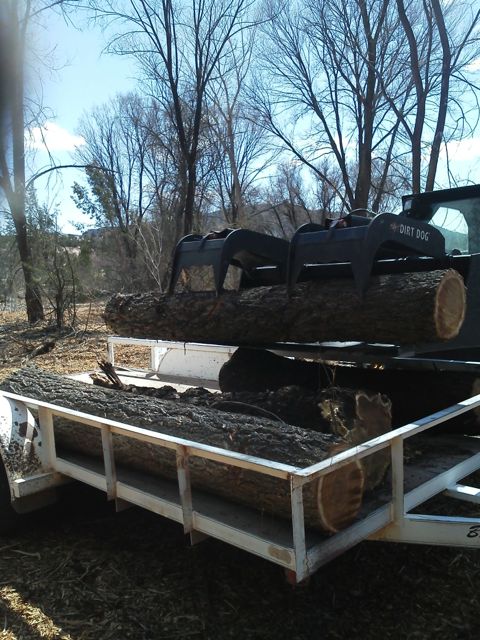
We cut and loaded quite a pile of these trees along with a few large Russian Olive trees and I hauled them to the saw mill.
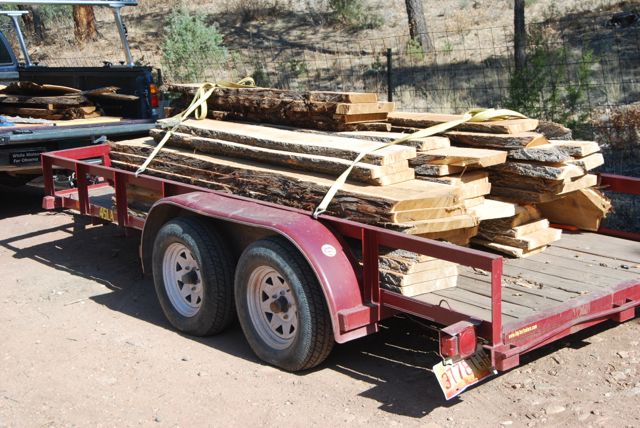
To properly cure lumber so that it stays flat and stable while drying it you have to stack it on a flat surface and put sticks between each layer to allow for air flow around each plank.
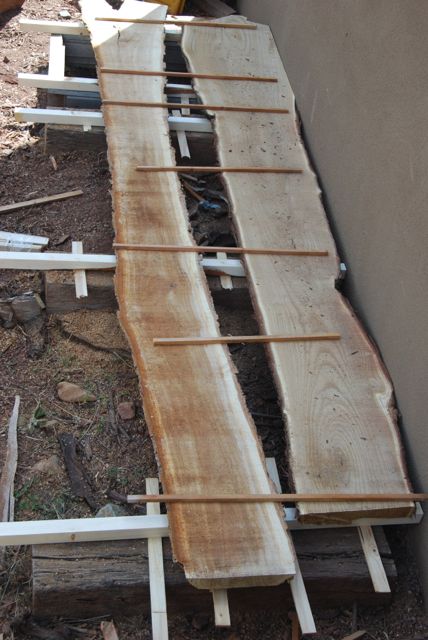 I stacked all these logs in 'boules' where you put the planks back in the order they came out of the tree. It helps to keep the lumber flat if you stack the pile high. The weight of the wood keeps planks from twisting while drying.
I stacked all these logs in 'boules' where you put the planks back in the order they came out of the tree. It helps to keep the lumber flat if you stack the pile high. The weight of the wood keeps planks from twisting while drying.
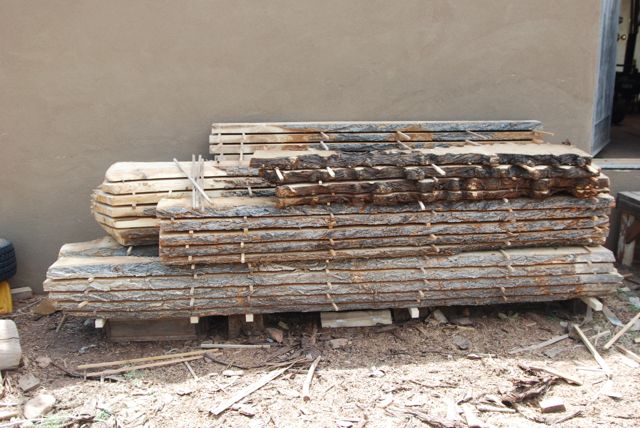
Now it's a waiting game. It will take a year or so to dry this lumber in our NM climate. Back east these 2" thick planks would take twice that long.








